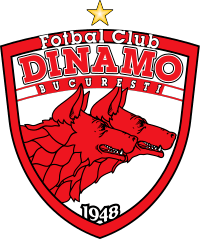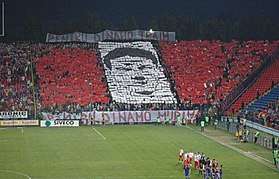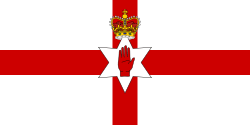FC Dinamo București
 | ||||
| Full name | Fotbal Club Dinamo București | |||
|---|---|---|---|---|
| Nickname(s) |
| |||
| Short name | Dinamo | |||
| Founded | 14 May 1948 | |||
| Ground |
Stadionul Dinamo Arena Națională (some matches) | |||
| Capacity | 15,032 | |||
| Owner | Ionuț Negoiță | |||
| Chairman | Alexandru David | |||
| Coach | Mircea Rednic | |||
| League | Liga I | |||
| 2017–18 | Liga I, 7th | |||
| Website | Club website | |||
|
| ||||
| Football | Men's Handball | Women's Handball |
|---|---|---|
| Hockey | Basketball | Water polo |
| Men's Volleyball | Women's Volleyball | Rugby |
| Martial arts | Athletics | Boxing |
| Kayak | Canoe | Cycling |
| Gymnastics | Weightlifting | Judo |
| Modern Karate | Wrestling | Swimming |
| Fencing | Shooting | Taekwondo |
| Tennis | Chess | Skiing |
Fotbal Club Dinamo București (Romanian pronunciation: [diˈnamo bukuˈreʃtʲ]), commonly known as Dinamo București, or simply as Dinamo within Romania, is a Romanian professional football club based in Bucharest.
Founded in 1948, it has spent its entire history in Liga I, the top tier of the Romanian football league system. Domestically, Dinamo București is one of the two most successful teams in Romania, having won 18 Liga I titles, 13 Cupa României, two Supercupa României, and one Cupa Ligii. In the 1983–84 season, they became the second Romanian club to reach the semi-finals of the European Cup.
Dinamo's traditional home colours are white red, while the current crest is a modified version of the one adopted in the 1998. They are currently playing on the Arena Națională, their stadium being renovated for UEFA Euro 2020.
The club holds a strong rivalry with neighbouring FC Steaua București, with matches between the two being commonly referred to as "the Eternal Derby".
History
Dinamo was founded on 14 May 1948, when "Unirea Tricolor MAI" – newly entered, in January 1948, under the umbrella of the Communist regime's Internal Affairs Ministry – merged with "Ciocanul București". The sporting club represented the above-mentioned institution.[1] The "Dinamo" name was used for the very first time on 1 May 1948. Nevertheless, the real debut of Dinamo was in the 1947-48 Divizia A edition (finishing 8th). Some of the team's players were Ambru, Angelo Niculescu, Teodorescu, Siclovan, Bartha, and Sârbu. In 1955, Dinamo won their first championship. With Angelo Niculescu as head coach, Dinamo impressed mainly in the offensive, with an attack formed by Ene I, Neaga and Suru. The defense, with players like Băcuț I, Băcuț II, Szoko, Călinoiu, was the best in the championship – only 19 goals against.[2]
In the fall of 1956, the team made its debut in the European Champion Clubs' Cup (competition created a year before). Dinamo was the first Romanian team to play in the European competitions. The debut game was played on 26 August 1956, in front of 32,000 spectators. Dinamo defeated Galatasaray, 3–1. In the second leg, Dinamo lost in Istanbul 1–2, and moved forward.
In following years, Dinamo met famous teams in Europe, such as Real Madrid (a team with Di Stefano and Gento – the game played in Bucharest took place at 23 August Stadium, and established a new record for this arena: 100,000 spectators[3]), Inter Milan and Feyenoord: 0–3 and 0–2.
In 1973, in the European Cup, Dinamo surpassed Northern Ireland's Crusaders Belfast. The 11–0 home game against Northern Ireland's team is still the biggest margin of victory in the history of the European Cup.
The autumn of 1983–84 was going to represent a valuable step into the international arena. The "European Champions Cup campaign" started with the Finnish team, Kuusysi Lahti (1–0 and 3–0). The second round pushed Dinamo against the current champion, Hamburger SV – team of Stein, Kalz and Magath. At Bucharest, Augustin, Multescu and Orac scored for 3–0.[4][5] The thrilling second leg finished 3–2 (goals Țălnar and Mulțescu). In order to accede to the semi-finals of CCE, Dinamo had to defeat another top team: Dinamo Minsk, with Aleinikov, Zigmanatovich and Gurinovich. The first leg was 1–1 (Rednic equalizing in the 87th minute), and it was followed by a 1–0 victory at Bucharest (with Augustin scoring). Dinamo was the first Romanian team to reach the European Champions Cup semi-finals,[6] where it met Liverpool F.C.. Dinamo lost 1–0 at Anfield and 2–1 in Bucharest, as Liverpool progressed to the 1984 European Cup Final.
In 1986 Dinamo won the Cup against Steaua, the team that only a few days before won the European Cup.

In the summer of 1990, Dinamo – with Mircea Lucescu as coach – conquered a new national title, the 13th. Also the team won the Cup final, against Steaua: 6–4. But the Romanian Revolution from 1989 opened the doors for the Romanian footballers to leave and play abroad and Dinamo lost almost its entire team, thus a downfall regarding the results came the following years.
Dinamo managed to win the title in 1992, 2000, 2002, 2004 and 2007, but failed to reach the final phases of the European competitions.
In 2013, the team changed ownership. Businessman Ionuț Negoiță bought the club and promised to revive the golden years.[7]
On May 6, 2016, player Patrick Ekeng collapsed on the field and was diagnosed with a heart attack. He was declared dead at the hospital 2 hours later.[8]
Crest and colours
Since the beginning, Dinamo's colours were red and white. The current team's badge includes two red dogs, a nickname given to the club when the Nunweiller brothers played here, Radu and Ion, in the 1960s and 1970s.
Stadium
.jpg)
Dinamo plays its home games at Stadionul Dinamo. The arena was built in 1951, and for the official inauguration Dinamo played a game against Locomotiva Timișoara. Initially, the stadium capacity was 16,000, but following the installation of seats, it decreased to 15,032 places. The stadium is part of a larger complex which contains another smaller stadium, Stadionul Florea Dumitrache, where the second team, Dinamo II, used to play its matches. It is currently used by CS Dinamo București rugby team. There is also a sports hall and a swimming pool.
The stadium is nicknamed "Groapa" (The Pit), because it was built by digging a hole, rather than by raising its stands. Dinamo's fans use the North stand, named Peluza Cătălin Hîldan, after a former Dinamo player who died in 2000 at the age of 24.
Dinamo also plays home and away matches against their biggest rivals, Steaua, as well as other major fixtures at Arena Națională.
Support
Dinamo has an estimated 11% support in Romania, making them the second most supported Romanian club, after Steaua.[9] The largest concentration of fans is in Bucharest, mainly in the northeast and central areas of the city. The club also has important fan bases inside and outside the country.

The roots of the Dinamo ultras movement can be found in 1995 when groups like Dracula and Rams Pantelimon appeared in the North End. In 1996 a group called Nuova Guardia was formed, and became the leading group in the stadium and later on in the entire Romanian ultras movement.[10] Following the death of the former captain, Cătălin Hîldan, in 2000, the fans renamed the North End of Dinamo's stadium to Peluza Catalin Hîldan (PCH Stand) in his honor. The majority of supporters are located in the PCH, but several factions have moved to the South End.
Rivalries
Dinamo's most important rivalry is with Steaua București. The match between them, dubbed the Eternal derby, has been the leading Romanian football encounter in the last 60 years, as the two clubs are the most successful in the country. Clashes between different factions of supporters have often occurred and still occur inside and outside the stadium. In 1997, Dinamo's fans set a sector of the Stadionul Ghencea on fire.[11] On 16 August 2016, during Steaua's UEFA Champions League 0–5 play-off loss against Manchester City, undercover Dinamo fans displayed a huge message reading Doar Dinamo București ("Only Dinamo Bucharest"), which was labelled one of the biggest pranks in football history.[12]
The club's second most important rivalry is against Rapid Bucuresti. In the 1990's, there was fierce competition between the two in winning the Divizia A (now Liga I).
Another rivalry is held against Universitatea Craiova. Both finished with the same number of points in the 1972–73 Divizia A, but Dinamo was given the title because of their superior goal difference. A conflict has existed ever since.[13][14]
Youth program
Dinamo has an important infrastructure for training and preparing children towards professionalism. The youth center has nine organised groups managed by age categories, for children between nine and 18 years. In total, Dinamo has around 180 juniors.
All the groups play in the competitions organised by the Bucharest Football Association and in those created by the Romanian Federation. Youths around 16–18 years old are promoted to the second team, Dinamo II.
The youth center has its base in the Dinamo Sports Center, where they have eight dressing rooms for the players, one for the coaches, one for the referees, a medical center and a store room for the equipment. Also, the center has many training grounds, among them the Piți Varga field.[15]
Honours
Domestic
Leagues
- Liga I
- Winners (18): 1955, 1961–62, 1962–63, 1963–64, 1964–65, 1970–71, 1972–73, 1974–75, 1976–77, 1981–82, 1982–83, 1983–84, 1989–90, 1991–92, 1999–00, 2001–02, 2003–04, 2006–07
- Runners-up (20): 1951, 1952, 1953, 1956, 1958–59, 1960–61, 1966–67, 1968–69, 1973–74, 1975–76, 1978–79, 1980–81, 1984–85, 1986–87, 1987–88, 1988–89, 1992–93, 1998–99, 2000–01, 2004–05
Cups
- Cupa României
- Supercupa României
- Cupa Ligii
- Winners (1): 2016–17
Players
First team squad
- As of 2 October 2018
Note: Flags indicate national team as defined under FIFA eligibility rules. Players may hold more than one non-FIFA nationality.
|
|
Out on loan
Note: Flags indicate national team as defined under FIFA eligibility rules. Players may hold more than one non-FIFA nationality.
|
|
Retired numbers
11 – ![]()
14 – ![]()
Club officials
Board of directors
|
Current technical staff
|
Statistics and records
European cups all-time statistics
As of August 3, 2017.
| Competition | S | P | W | D | L | GF | GA | GD |
|---|---|---|---|---|---|---|---|---|
| UEFA Champions League / European Cup | 18 | 66 | 24 | 10 | 32 | 96 | 106 | – 10 |
| UEFA Cup Winners' Cup / European Cup Winners' Cup | 5 | 20 | 8 | 4 | 8 | 25 | 18 | + 7 |
| UEFA Europa League / UEFA Cup | 23 | 90 | 37 | 14 | 39 | 147 | 127 | + 20 |
| UEFA Intertoto Cup | 1 | 4 | 1 | 0 | 3 | 4 | 6 | – 2 |
| Total | 47 | 180 | 70 | 28 | 82 | 272 | 257 | + 15 |
Records in the league:
- Consecutive winning games: 17 games (12 June 1988 – 27 November 1988)
- Best unbeaten run: 47 games (26 May 1991 – 20 September 1992)
- Player with most appearances:

- Top scorer:

- Top scorer in international games:

Records in the European competition:
- Biggest home win: Dinamo 11–0

- Biggest away win:

- Heaviest home defeat: Dinamo 0–3


- Heaviest away defeat:

Notable former players
The footballers enlisted below have had international cap(s) for their respective countries at junior and/or senior level and/or more than 100 caps for FC Dinamo București.
|
|
|
Notable former managers
References
- ↑ Dinamo (2009). "O POVESTE MEREU FRUMOASA" (in Romanian). fcdinamo.ro.
- ↑ Fun Club Dinamo (2009). "Campionat 1955" (in Romanian). fanclubdinamo.freeservers.com.
- ↑ Lucian Ionescu (2007). "Istorie stadion Național" (in Romanian). sportm.ro. Archived from the original on 14 November 2012.
- ↑ fcdinamo.ro (2008). "VIDEO / Dinamo – Hamburg 3 – 0" (in Romanian). fcdinamo.ro.
- ↑ mysport.ro (2008). "Mai buni decît cei mai buni!" (in Romanian). dinamovisti.mysport.ro. Archived from the original on 22 October 2009.
- ↑ fcdinamo.ro (2008). "Prima echipă românească în semi-finalele CCE" (in Romanian). fcdinamo.ro.
- ↑ Ionuț Negoiță este noul ACȚIONAR MAJORITAR de la DINAMO!
- ↑ "Dinamo Bucharest midfielder Patrick Ekeng dies after collapsing on pitch". The Guardian. 6 May 2016.
- ↑ Centrul de Studii si Cercetari Infopolitic (2016). "Studiu: 49% dintre români ţin cu Steaua. Câți au optat pentru Dinamo sau Astra" (in Romanian). www.dolce-sport.ro.
- ↑ A.G.M.Dinamo (2009). "La multi ani Nuova Guardia" (in Romanian). agmdinamo48.blogspot.com.
- ↑ Ziare.com (2009). "Dinamovistii sarbatoresc 12 ani de la incendierea peluzei din Ghencea" (in Romanian). ziare.com.
- ↑ "Dinamo Bucharest fans pull off one of the biggest pranks in football as they unveil mosaic of their name at rivals Steaua's ground". Daily Mail. Retrieved 17 August 2016.
- ↑ "CRAIOVA-DINAMO. Titlul pierdut dubios în '73 a generat ura oltenilor" [CRAIOVA-DINAMO. The title lost in a strange way in '73 generated the hate of "the People of Oltenia"] (in Romanian). Fanatik.ro. 22 April 2017. Retrieved 29 April 2018.
- ↑ "CS U Craiova - Dinamo, orgoliul a rămas, obiectivele s-au schimbat" [CS U Craiova - Dinamo, the pride remains, the objectives have changed] (in Romanian). Telekom Sport. 16 September 2017. Retrieved 29 April 2018.
- ↑ fcdinamo.ro. "CENTRUL DE COPII SI JUNIORI. Viitorul fotbalului dinamovist" (in Romanian). fcdinamo.ro.
- ↑ Steaua gave up the trophy in 1990.
- ↑ http://www.dolce-sport.ro/fotbal/fotbal-intern/steaua-dinamo-1988-cupa-mircea-lucescu-anghel-iordanescu-44101/
- ↑ The goal of Gabi Balint was canceled because of an offside, signalled by assistant referee George Ionescu. Steaua retired from the field (by command of Valentin Ceaușescu, son of president Nicolae Ceaușescu) but the Romanian Football Federation offered the Cup to Steaua București. In 1990, Steaua renounced this trophy because it was won unjustly.